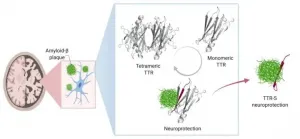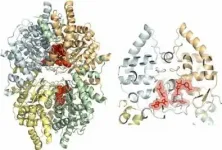High-flux table-top source for femtosecond hard X-ray pulses
2021-01-07
(Press-News.org) Femtosecond hard X-ray pulses are an important tool for unraveling structure changes of condensed matter on atomic length and time scales. A novel laser-driven X-ray source provides femtosecond copper Kα pulses at a 1 kHz repetition rate with an unprecedented flux of some 10^12 X-ray photons per second.
Elementary processes in physics, chemistry, and biology are connected with changes of the atomic or molecular structure on a femtosecond time scale (1 femtosecond (fs) = 10^-15 seconds). Ultrafast X-ray methods hold strong potential for following structure changes in space and time and generate 'movies' of the motions of electrons, atoms and molecules. This perspective has resulted in a strong demand for femtosecond hard X-ray pulses to be applied in X-ray scattering and spectroscopy.
There are two main approaches to generate ultrashort hard X-ray pulses. The first are sources based on large-scale electron accelerators and undulators in which femtosecond electron bunches radiate bright X-ray pulses. The second are small-frame laboratory sources driven by intense femtosecond optical lasers. Here, electron acceleration occurs in the strong electric field of an optical pulse and X-ray pulses are generated by collisional interaction of such electrons with atoms of a metal target, similar to a conventional X-ray tube.
Researchers at the Max Born Institute (MBI) in Berlin have now accomplished a breakthrough in table-top generation of femtosecond X-ray pulses by demonstrating a stable pulse train at kilohertz repetition rate with a total flux of some 10^12 X-ray photons per second. As they report in Optics Letters, the combination of a novel optical driver providing femtosecond mid-infrared pulses around a 5 μm (5000 nm) wavelength with a metallic tape target in a transmission geometry allows for generating hard X-ray pulses at a wavelength of 0.154 nm with very high efficiency.
The optical driver is based on optical parametric chirped pulse amplification (OPCPA) and provides 80-fs pulses at a central wavelength of 5 μm with an energy of 3 mJ and a repetition rate of 1 kHz. To generate X-ray pulses, the mid-infrared pulses are tightly focused onto a thin copper target (Fig 1). In an optical cycle of the optical field, electrons are extracted from the copper tape, accelerated in vacuum and steered back to the target. Electrons with a kinetic energy of up to 100 keV reenter the target and generate bright copper Kα pulses at a wavelength of 0.154 nm, accompanied by spectrally broad bremsstrahlung. The longer optical cycle of the mid-infrared pulses compared to pulses at shorter optical wavelengths results in longer acceleration times of the electrons, higher kinetic energies, and eventually higher efficiency in X-ray generation (Fig. 2).
The new table-top X-ray source reaches an average number of Cu-Kα photons up to 1.5x10^9 photons per pulse in the full solid angle or 1.5x10^12 photons per second (blue dots in Fig 2c). This photon flux is 30 times higher than from commonly used table-top X-ray sources driven by Ti:sapphire lasers at the central wavelength of 0.8 μm (black dots in Fig 2c). Such source parameters open exciting perspectives for investigating ultrafast structure changes in condensed matter by time-resolved X-ray scattering.
INFORMATION:
[Attachments] See images for this press release:

ELSE PRESS RELEASES FROM THIS DATE:
2021-01-07
The Covid-19 pandemic is impacting people's mental health. But what helps and hinders people in getting through a lockdown? A new study led by researchers at the University of Basel addressed this question using data from 78 countries across the world. The results hint at the pivots and hinges on which the individual's psyche rests in the pandemic.
At the outset of the Covid-19 pandemic, little was known about the impact of population-wide governmental lockdowns. What was known was taken from restricted quarantines of small groups of people. "On the one hand, such drastic changes to daily routines can be detrimental to mental health," explains Professor ...
2021-01-07
People view the wolf as either a threatening predator or a sign of a healthy natural habitat. Many proponents of nature and animal conservation welcome the spread of wolf populations in Germany. By contrast, farmers who graze herds directly impacted by the wolves' return are more critical. The team of Nicolas Schoof, Prof. Dr. Albert Reif of the Chair of Site Classification and Vegetation Science at the University of Freiburg, and Prof. Dr. Eckhard Jedicke of the Competence Center Cultural Landscape and the Department of Landscape Planning and Nature Conservation of Hochschule Geisenheim University has assessed the existing legal situation. On the basis of a range of environmental data they have determined the conflicts and drawn up possible solutions. In an article in ...
2021-01-07
Northeastern Asia has a complex history of migrations and plague outbursts. That is the essence of an international archaeogenetic study published in Science Advances and lead from the Department of Archaeology and Classical Studies at Stockholm University. Genomic data from archaeological remains from 40 individuals excavated in northeastern Asia were explored in the study.
"It is striking that we find everything here, continuity as well as recurrent migrations and also disease-related bacteria", says Anders Götherström, professor at the Center for Palaeogenetics at Stockholm University and one of the Principal investigators of the study.
The ...
2021-01-07
Sleep is ubiquitous in animals and humans and vital for healthy functioning. Thus, sleep after training improves performance on various tasks in comparison to equal periods of active wakefulness. However, it has been unclear so far whether this is due to an active refinement of neural connections or merely due to the absence of novel input during sleep. Now researchers at the Medical Center - University of Freiburg have succeeded in showing that sleep is more than rest for improving performance. The findings, which were published in the journal SLEEP on January 6, 2021, provide important information for planning periods of intensive ...
2021-01-07
January 7, 2021 (BRAMPTON - HAMILTON) -- When dealing with a life-limiting illness, palliative care can improve the quality of life for patients and families. However, for many people, the fear of "end of life" care prevents them from exploring it. A recent study from William Osler Health System (Osler) and McMaster University examined awareness of palliative care in the South Asian community and found that culture plays a critical role in the perception of palliative care. This perception, in turn, affects whether or not patients will be open to receiving it.
Funded by a McMaster University, Department ...
2021-01-07
TORONTO, January 7, 2021- What feels like up may actually be some other direction depending on how our brains process our orientation, according to psychology researchers at York University's Faculty of Health.
In a new study published in PLoS One, researchers at York University's Centre for Vision Research found that an individual's interpretation of the direction of gravity can be altered by how their brain responds to visual information. Laurence Harris, a professor in the Department of Psychology in the Faculty of Health and Meaghan McManus, a graduate student in his lab, found, using virtual reality, that people differ ...
2021-01-07
DALLAS - Jan. 7, 2020 - A protein that wreaks havoc in the nerves and heart when it clumps together can prevent the formation of toxic protein clumps associated with Alzheimer's disease, a new study led by a UT Southwestern researcher shows. The findings, published recently in the Journal of Biological Chemistry, could lead to new treatments for this brain-ravaging condition, which currently has no truly effective therapies and no cure.
Researchers have long known that sticky plaques of a protein known as amyloid beta are a hallmark of Alzheimer's and are toxic to brain cells. As early as the mid-1990s, other proteins were discovered in these plaques as well.
One of these, a protein known as transthyretin (TTR), ...
2021-01-07
Brazilian researchers have managed to decipher the structure of a protein found in parasites that cause neglected tropical diseases, paving the way to the development of novel medications. Thanks to the discovery it will be possible to seek more potent molecules capable of destroying the pathogens directly, with fewer adverse side-effects for patients.
The study detailed the structural characteristics of the protein deoxyhypusine synthase (DHS), found in Brugia malayi, one of the mosquito-borne parasites that cause elephantiasis, and in Leishmania major, the protozoan that causes cutaneous leishmaniasis.
Elephantiasis, also known as lymphatic filariasis, is an infection of the lymph system that can lead to swelling of the legs, arms, and genitalia. It may also harden and ...
2021-01-07
HOUSTON - (Jan. 7, 2021) - Proteogenomic analysis may offer new insight into matching cancer patients with an effective therapy for their particular cancer. A new study identifies three molecular subtypes in head and neck squamous cell carcinoma (HNSCC) that could be used to better determine appropriate treatment. The research led by Baylor College of Medicine, Johns Hopkins University and the National Cancer Institute's Clinical Proteomic Tumor Analysis Consortium (CPTAC) is published in the journal Cancer Cell.
Researchers profiled proteins, phosphosites and signaling ...
2021-01-07
TROY, N.Y. -- In a money-saving revelation for organizations inclined to invest in specialized information technology to support the process of idea generation, new research suggests that even non-specialized, everyday organizational IT can encourage employees' creativity.
Recently published in the journal Information and Organization, these findings from Dorit Nevo, an associate professor in the Lally School of Management at Rensselaer Polytechnic Institute, show standard IT can be used for innovation. Furthermore, this is much more likely to happen when the technology is in the hands of employees who are motivated to master technology, understand their role in the organization, ...
LAST 30 PRESS RELEASES:
[Press-News.org] High-flux table-top source for femtosecond hard X-ray pulses


